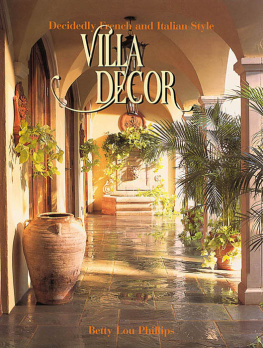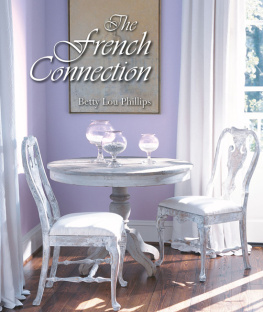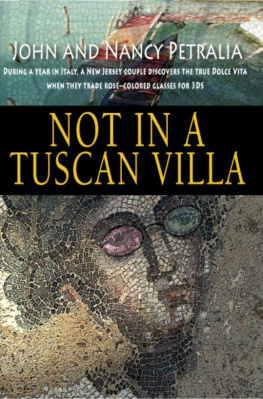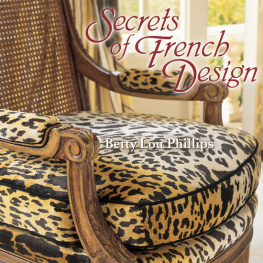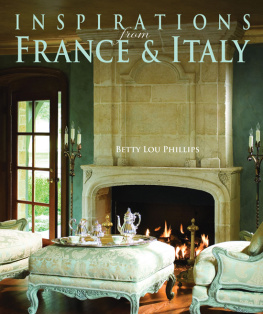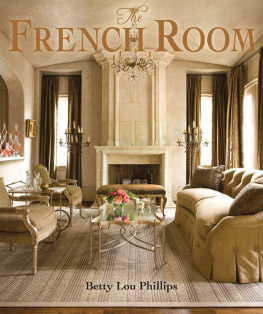Villa Decor
Decidedly French and Italian Style
Betty Lou Phillips

Villa Decor
Decidedly French and Italian Style
Digital Edition v1.0
Text 2002 Betty Lou Phillips
Photographic credits as noted in credits section
All rights reserved. No part of this book may be reproduced by any means whatsoever without written permission from the publisher, except brief portions quoted for purpose of review.
Gibbs Smith, Publisher
PO Box 667
Layton, UT 84041
Orders: 1.800.835.4993
www.gibbs-smith.com
ISBN: 978-1-4236-2171-3
Front Cover: Whenever I go, I am surrounded by these beautiful objects... and all is Italian; not a house, not a shed, not a field that the eye can for a moment imagine to be American, Ralph Waldo Emerson once said. But only because he had not happened upon the villa featured on the cover. Although it might well be set in Italy, proudly it stands in the States with the sun streaming through arches framing the loggia. Fountain is from Le Louvre Antiques, Dallas, Texas.
Acknowledgements
Above all, one must not believe that beauty is a good fortune that only a few can obtain.
Ellen Key
Like most books, Villa Dcor was a collaborative effort. I am especially grateful to the gifted designers who allowed us to photograph their work: Roberto Agnolini, John Bobbitt, Gerrie Bremermann, Margaret Chambers, Donald Coan, Price Dixon, Sherry Hayslip, Dianne Josephs, John Kidd, Janie Petkus, Christina Phillips, Marilyn Phillips, Lynn Sears, Tony Stavish, Cecilia Talley, Clair Talley, Beau Theriot, Richard Trimble, Rebecca Turner Wiggins, Deborah Fain Walker, Liz Lank Williamson, and Warren Wyatt.
Thank you, too, to those who graciously opened the wrought-iron gates to their secluded estates, allowing us entry into their private worlds: Roberto Agnolini, Barbara and Barry Beracha, Jean Brainerd, Joan and Robert Donner, Kathleen Luby, Kelli and Christopher McGuire, George Pelletier, Sarah and Stephen Pitt, Bonnie and Bo Purvois, Pamela and Shane Reynolds, Evelyn Rucker, Sandy and Tom Rouse, Melinda and Mike Russ, Sarah and William Rutherford, Patrice and Charles Shelby, and many others.
An especially warm thank-you to the friends who kindly gave their time and energy or offered an introduction or an idea: Janet Altman, Ed Bickers, Judy Blackman, Donna Burley, Bruno de la Croix-Vaubois, Adrienne Doherty, Roblyn Herndon, Joe Lugo, Carol Seay, John Sebastian, Fannie Tapper, Jayne Taylor, Medora White, and Mike Williams.
Thank you to the most wonderful and effective public relations team an author could have: Doris Bass, Judy Blackman, Carole Lou Bruton, Jane Dunne, Linda Gibbons, Nancy ONeill, Linda Staley, and leader Medora White.
I have true admiration and appreciation for the talented photographers with whom I worked: Dan Piassick, Emily Minton, Janet Lenzen, Alise OBrien, and Jeffrey Millies.
Villa Dcor is also the result of the unfailing interest of editor Madge Baird, whose efforts I appreciate and friendship I value.
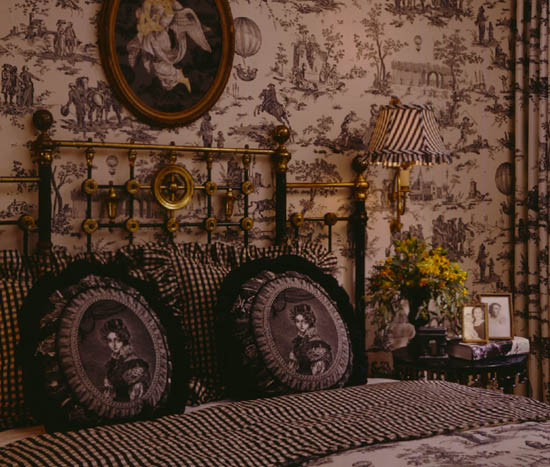
Surely, this imperial black-and-white guest room would have been the envy of Marie Antoinette, who was known to indulge her passion for toile. Both wallcovering and fabric are from Pierre Deux. Pillow fabric is by LeeJofa. Headboard is from Wallner Antiques in Chicago, while swing-arm lamps were air-freighted from Besselink & Jones, London.
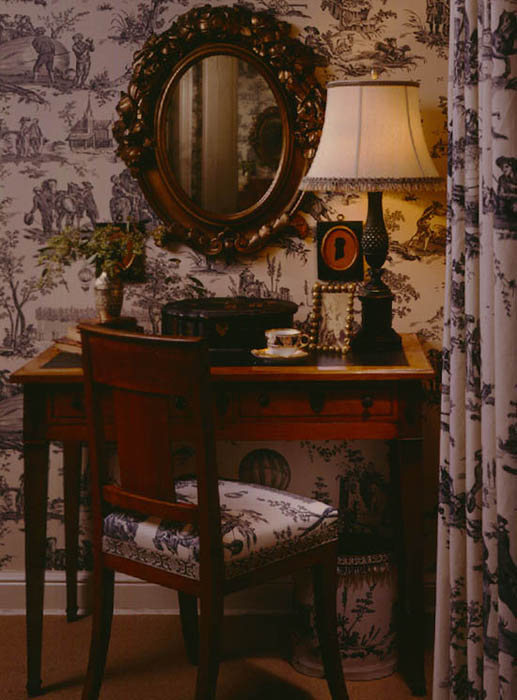
Transporting old-world elegance to a sumptuously dressed bedroom are a desk, chair, and accessories swept from Pariss flea markets. All stand camera ready in anticipation of weekend guests. Fabled toiles came to the United States after the American Revolution. Popular as they are, Americans still use them more sparingly than the French. We are also more likely to mix them with solids, stripes, and checks. The key to deft blending is staying within one colorway.
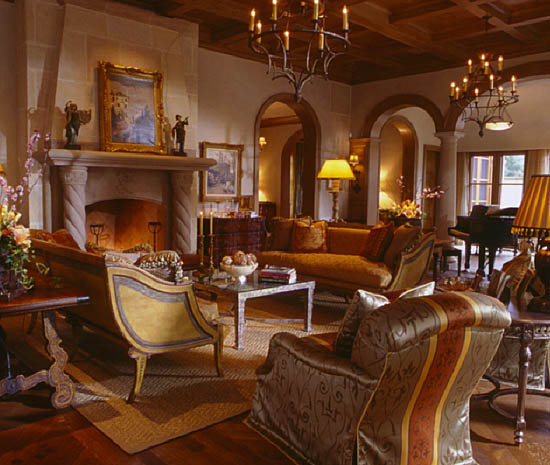
As befitting an Italianate villa, furnishings are not only of similar visual weight but also in scale with a sumptuous space revering symmetry. Matching Italian sleigh sofas from Cache anchor the room, with chairs from the Cameron Collection settled nearby. The leather bench is from Therien & Company, San Francisco, while the coffee tabletop was once an antique iron gate. Roman baths sprayed with flowers date from the seventeenth century.
Introduction
Though we travel the world over to find the beautiful, we must carry it with us or we find it not.
Ralph Waldo Emerson
Some things never change: We observe, we listen, we learn, yet life is full of deep mysteries. Global economies rise and fall. And like countless Americans before us, we are irresistibly drawn to the beauty of Paris with its historic monuments, ancient fountains, and towering stone faades offering a glimpse of the citys fabled past. Also igniting passions that we tend to reserve for the arts are the archeological wonders of imperial Rome, fading frescos in Florence, and, of course, Venices decorative stonework.
Besotted, in fact, with everything in such legendary placesfrom the charming, shuttered villas flanked by potted plants to the shop windows filled with lengths of sumptuous hand-loomed silksit is hardly surprising that we would find inspiration, prompting fresh ideas and hard-to-resist desires.
Little wonder, then, that we surrender to an acquired taste for furnishings with quiet French elegance and the simplicity of the sweet life, or la dolce vita, as the Italians say, virtuously juxtaposing various periods and styles in widely diverse, satisfying rooms that are never dull and predictable, but when revamped call attention to our savoir-faire and recognize the pleasures of our globe-hopping.
These days, no one says a memorable appartement (residential suite) has to be one style, or that a pied--terre (the convenient escape from ones principal residence) cant be open to disparate, far-flung influences. The long-standing purist look is now last century. Suddenly, mixing furnishings from different eras and the unlikeliest of places is much more chic.
Taking advantage of todays creative freedom, we rely on our instincts for defining bon got and gathering important objets dart, glittering rock-crystal chandeliers, graceful iron gates, whatever, from assorted nations but most notably Italy and France. Conventional wisdom has it, after all, that the unerring style of these countries stems from the elegance of their people, habitus forever synonymous with timeless good taste, sophisticated assurance, decorative ingenuity, and startling panache. As Shakespeare sagely pointed out, What is the city but the people?
So it follows that, equally influenced by the Italians and the French, we justly praise the accoutrements that set their worlds apart: dramatic architecture, celebrated cultures, well-tended gardens, and strong classic interiors.
Daringly then, we fuse the very influences for which the French and Italian people are known, artfully sculpting uniquely American visions of twenty-first-century uptown living with, at best, breathtaking creativity and astonishing harmony and warmth.

